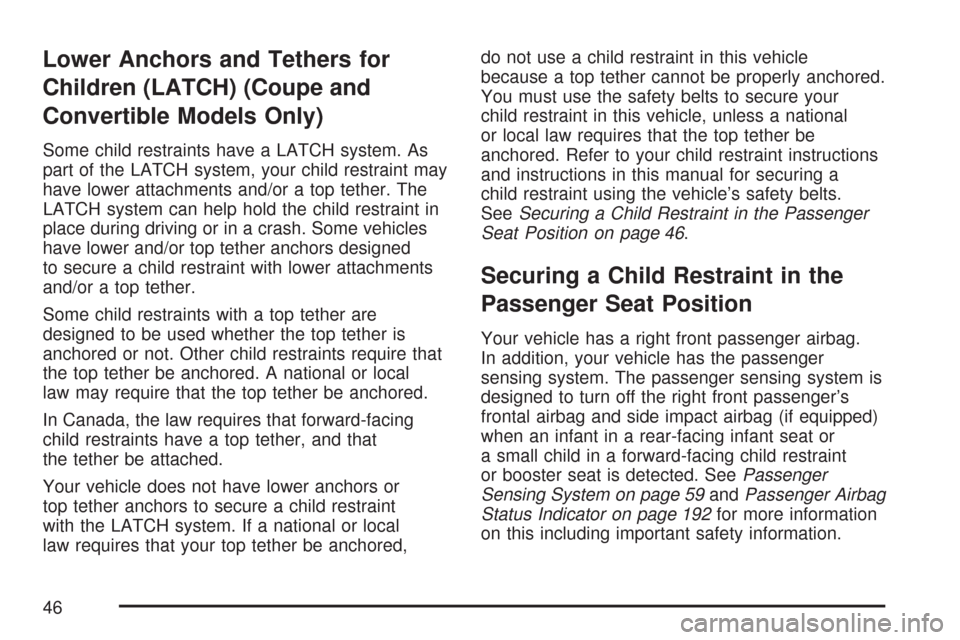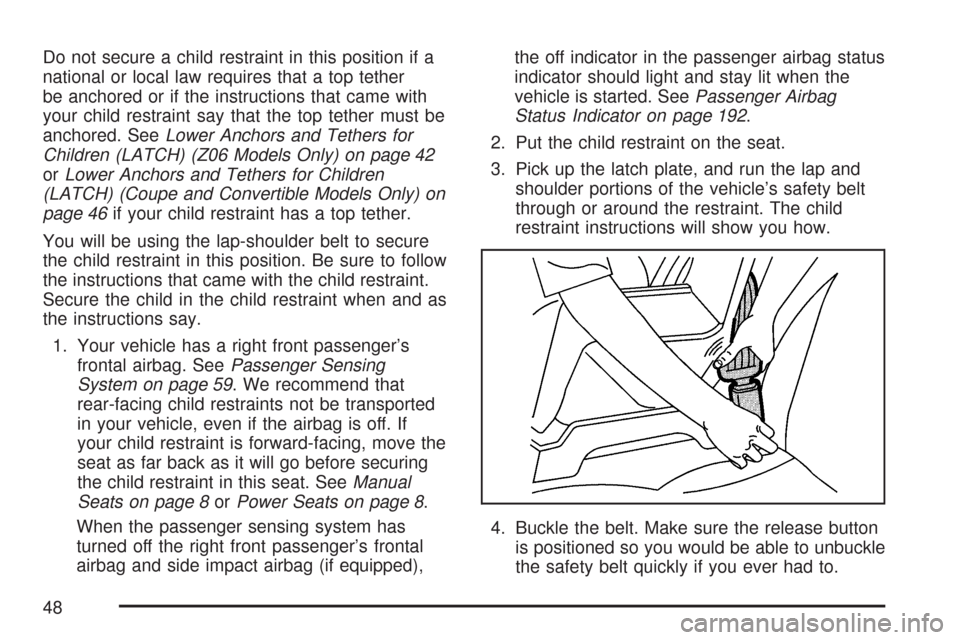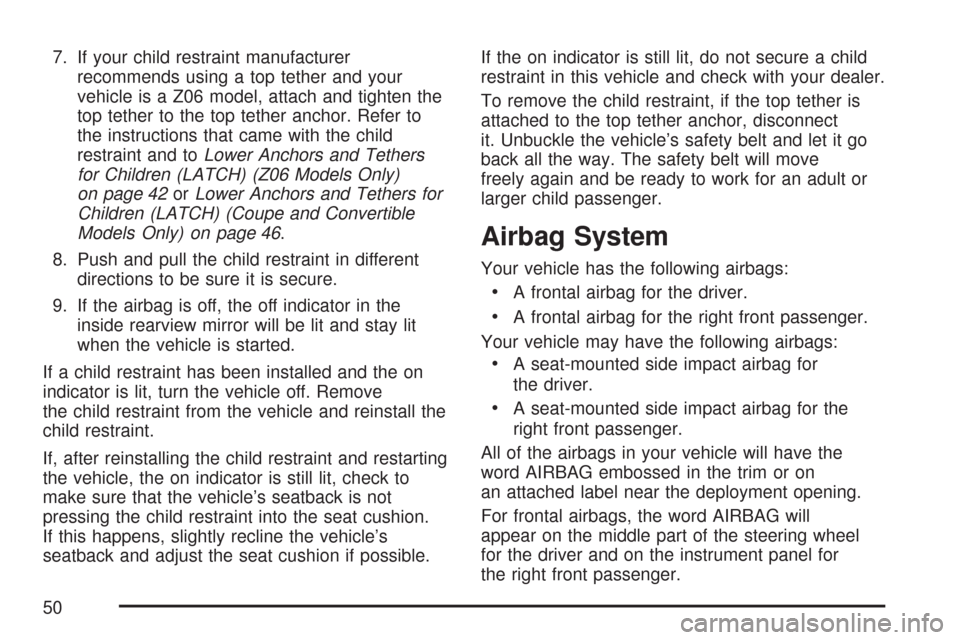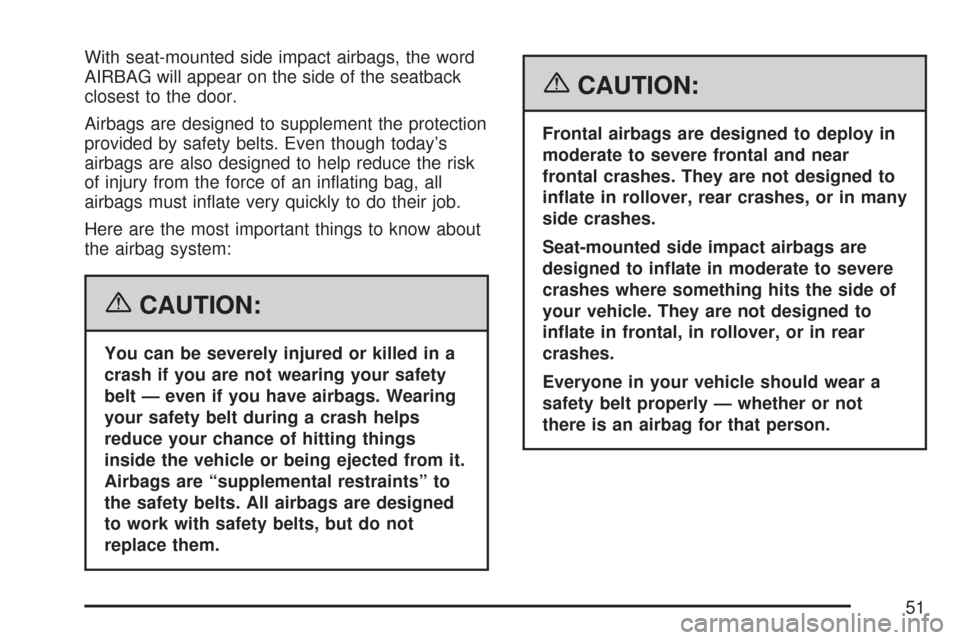Page 42 of 488

Lower Anchors and Tethers for
Children (LATCH) (Z06 Models Only)
Some child restraints have a LATCH system. As
part of the LATCH system, your child restraint may
have lower attachments and/or a top tether. The
LATCH system can help hold the child restraint in
place during driving or in a crash. Some vehicles
have lower and/or top tether anchors designed
to secure a child restraint with lower attachments
and/or a top tether.
Your vehicle does not have lower anchors to
accommodate lower attachments. Your vehicle
does have a top tether anchor. If your child
restraint has a top tether, make sure your child
restraint is properly installed using the top
tether anchor and the vehicle’s safety belt. A child
restraint must never be installed using only the
top tether and anchor. Refer to your child restraint
instructions and seeSecuring a Child Restraint
in the Passenger Seat Position on page 46
for instructions on securing your child restraint
using the vehicle’s safety belts.In order to use the top tether anchors in your
vehicle, you need a child restraint equipped with a
top tether. The child restraint manufacturer will
provide you with instructions on how to use
the child restraint and its top tether. The following
explains how to attach a child restraint with the
top tether in your vehicle.
A top tether (A, C) anchors the top of the child
restraint to the vehicle. A top tether anchor is built
into the vehicle.
42
Page 44 of 488
The top tether anchor is located behind the
passenger seat.
Securing a Child Restraint with a Top
Tether
{CAUTION:
If a LATCH-type child restraint is not
attached to anchors, the restraint will not
be able to protect the child correctly. In a
crash, the child could be seriously injured
or killed. Make sure that a LATCH-type
child restraint is properly installed using
the anchors, or use the vehicle’s safety
belts to secure the restraint, following the
instructions that came with that restraint,
and also the instructions in this manual.
1. Secure the child restraint using the vehicle’s
safety belt. SeeSecuring a Child Restraint in
the Passenger Seat Position on page 46.
44
Page 46 of 488

Lower Anchors and Tethers for
Children (LATCH) (Coupe and
Convertible Models Only)
Some child restraints have a LATCH system. As
part of the LATCH system, your child restraint may
have lower attachments and/or a top tether. The
LATCH system can help hold the child restraint in
place during driving or in a crash. Some vehicles
have lower and/or top tether anchors designed
to secure a child restraint with lower attachments
and/or a top tether.
Some child restraints with a top tether are
designed to be used whether the top tether is
anchored or not. Other child restraints require that
the top tether be anchored. A national or local
law may require that the top tether be anchored.
In Canada, the law requires that forward-facing
child restraints have a top tether, and that
the tether be attached.
Your vehicle does not have lower anchors or
top tether anchors to secure a child restraint
with the LATCH system. If a national or local
law requires that your top tether be anchored,do not use a child restraint in this vehicle
because a top tether cannot be properly anchored.
You must use the safety belts to secure your
child restraint in this vehicle, unless a national
or local law requires that the top tether be
anchored. Refer to your child restraint instructions
and instructions in this manual for securing a
child restraint using the vehicle’s safety belts.
SeeSecuring a Child Restraint in the Passenger
Seat Position on page 46.
Securing a Child Restraint in the
Passenger Seat Position
Your vehicle has a right front passenger airbag.
In addition, your vehicle has the passenger
sensing system. The passenger sensing system is
designed to turn off the right front passenger’s
frontal airbag and side impact airbag (if equipped)
when an infant in a rear-facing infant seat or
a small child in a forward-facing child restraint
or booster seat is detected. SeePassenger
Sensing System on page 59andPassenger Airbag
Status Indicator on page 192for more information
on this including important safety information.
46
Page 48 of 488

Do not secure a child restraint in this position if a
national or local law requires that a top tether
be anchored or if the instructions that came with
your child restraint say that the top tether must be
anchored. SeeLower Anchors and Tethers for
Children (LATCH) (Z06 Models Only) on page 42
orLower Anchors and Tethers for Children
(LATCH) (Coupe and Convertible Models Only) on
page 46if your child restraint has a top tether.
You will be using the lap-shoulder belt to secure
the child restraint in this position. Be sure to follow
the instructions that came with the child restraint.
Secure the child in the child restraint when and as
the instructions say.
1. Your vehicle has a right front passenger’s
frontal airbag. SeePassenger Sensing
System on page 59. We recommend that
rear-facing child restraints not be transported
in your vehicle, even if the airbag is off. If
your child restraint is forward-facing, move the
seat as far back as it will go before securing
the child restraint in this seat. SeeManual
Seats on page 8orPower Seats on page 8.
When the passenger sensing system has
turned off the right front passenger’s frontal
airbag and side impact airbag (if equipped),the off indicator in the passenger airbag status
indicator should light and stay lit when the
vehicle is started. SeePassenger Airbag
Status Indicator on page 192.
2. Put the child restraint on the seat.
3. Pick up the latch plate, and run the lap and
shoulder portions of the vehicle’s safety belt
through or around the restraint. The child
restraint instructions will show you how.
4. Buckle the belt. Make sure the release button
is positioned so you would be able to unbuckle
the safety belt quickly if you ever had to.
48
Page 49 of 488
5. Pull the rest of the shoulder belt all the way
out of the retractor to set the lock.6. To tighten the belt, push down on the child
restraint, pull the shoulder portion of the belt
to tighten the lap portion of the belt and
feed the shoulder belt back into the retractor.
If you are using a forward-facing child
restraint, you may �nd it helpful to use your
knee to push down on the child restraint
as you tighten the belt. You should not be able
to pull more of the belt from the retractor
once the lock has been set.
49
Page 50 of 488

7. If your child restraint manufacturer
recommends using a top tether and your
vehicle is a Z06 model, attach and tighten the
top tether to the top tether anchor. Refer to
the instructions that came with the child
restraint and toLower Anchors and Tethers
for Children (LATCH) (Z06 Models Only)
on page 42orLower Anchors and Tethers for
Children (LATCH) (Coupe and Convertible
Models Only) on page 46.
8. Push and pull the child restraint in different
directions to be sure it is secure.
9. If the airbag is off, the off indicator in the
inside rearview mirror will be lit and stay lit
when the vehicle is started.
If a child restraint has been installed and the on
indicator is lit, turn the vehicle off. Remove
the child restraint from the vehicle and reinstall the
child restraint.
If, after reinstalling the child restraint and restarting
the vehicle, the on indicator is still lit, check to
make sure that the vehicle’s seatback is not
pressing the child restraint into the seat cushion.
If this happens, slightly recline the vehicle’s
seatback and adjust the seat cushion if possible.If the on indicator is still lit, do not secure a child
restraint in this vehicle and check with your dealer.
To remove the child restraint, if the top tether is
attached to the top tether anchor, disconnect
it. Unbuckle the vehicle’s safety belt and let it go
back all the way. The safety belt will move
freely again and be ready to work for an adult or
larger child passenger.
Airbag System
Your vehicle has the following airbags:
A frontal airbag for the driver.
A frontal airbag for the right front passenger.
Your vehicle may have the following airbags:
A seat-mounted side impact airbag for
the driver.
A seat-mounted side impact airbag for the
right front passenger.
All of the airbags in your vehicle will have the
word AIRBAG embossed in the trim or on
an attached label near the deployment opening.
For frontal airbags, the word AIRBAG will
appear on the middle part of the steering wheel
for the driver and on the instrument panel for
the right front passenger.
50
Page 51 of 488

With seat-mounted side impact airbags, the word
AIRBAG will appear on the side of the seatback
closest to the door.
Airbags are designed to supplement the protection
provided by safety belts. Even though today’s
airbags are also designed to help reduce the risk
of injury from the force of an in�ating bag, all
airbags must in�ate very quickly to do their job.
Here are the most important things to know about
the airbag system:
{CAUTION:
You can be severely injured or killed in a
crash if you are not wearing your safety
belt — even if you have airbags. Wearing
your safety belt during a crash helps
reduce your chance of hitting things
inside the vehicle or being ejected from it.
Airbags are “supplemental restraints” to
the safety belts. All airbags are designed
to work with safety belts, but do not
replace them.
{CAUTION:
Frontal airbags are designed to deploy in
moderate to severe frontal and near
frontal crashes. They are not designed to
in�ate in rollover, rear crashes, or in many
side crashes.
Seat-mounted side impact airbags are
designed to in�ate in moderate to severe
crashes where something hits the side of
your vehicle. They are not designed to
in�ate in frontal, in rollover, or in rear
crashes.
Everyone in your vehicle should wear a
safety belt properly — whether or not
there is an airbag for that person.
51
Page 52 of 488

{CAUTION:
Airbags in�ate with great force, faster
than the blink of an eye. Anyone who is
up against, or very close to, any airbag
when it in�ates can be seriously injured
or killed. Do not sit unnecessarily close to
the airbag, as you would be if you were
sitting on the edge of your seat or leaning
forward. Safety belts help keep you in
position before and during a crash.
Always wear your safety belt, even with
airbags. The driver should sit as far back
as possible while still maintaining control
of the vehicle.
Occupants should not lean on or sleep
against the door or side windows in
seating positions with seat-mounted
airbags.
{CAUTION:
Airbags plus lap-shoulder belts offer the
best protection for adults, but not for
young children and infants. Neither the
vehicle’s safety belt system nor its airbag
system is designed for them. Young
children and infants need the protection
that a child restraint system can provide.
Always secure children properly in your
vehicle. To read how, seeOlder Children
on page 31orInfants and Young Children
on page 34.
52